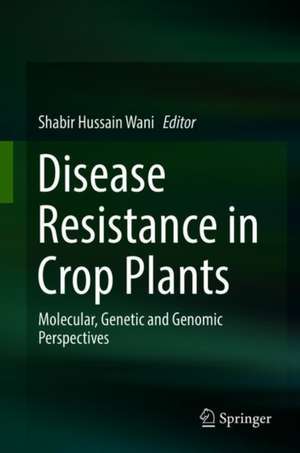Disease Resistance in Crop Plants: Molecular, Genetic and Genomic Perspectives
Editat de Shabir Hussain Wanien Limba Engleză Hardback – 5 aug 2019
| Toate formatele și edițiile | Preț | Express |
|---|---|---|
| Paperback (1) | 886.59 lei 38-44 zile | |
| Springer International Publishing – 15 aug 2020 | 886.59 lei 38-44 zile | |
| Hardback (1) | 895.53 lei 38-44 zile | |
| Springer International Publishing – 5 aug 2019 | 895.53 lei 38-44 zile |
Preț: 895.53 lei
Preț vechi: 1178.34 lei
-24% Nou
Puncte Express: 1343
Preț estimativ în valută:
171.41€ • 186.26$ • 144.08£
171.41€ • 186.26$ • 144.08£
Carte tipărită la comandă
Livrare economică 17-23 aprilie
Preluare comenzi: 021 569.72.76
Specificații
ISBN-13: 9783030207274
ISBN-10: 3030207277
Pagini: 392
Ilustrații: XII, 307 p. 15 illus. in color.
Dimensiuni: 155 x 235 mm
Greutate: 0.59 kg
Ediția:1st ed. 2019
Editura: Springer International Publishing
Colecția Springer
Locul publicării:Cham, Switzerland
ISBN-10: 3030207277
Pagini: 392
Ilustrații: XII, 307 p. 15 illus. in color.
Dimensiuni: 155 x 235 mm
Greutate: 0.59 kg
Ediția:1st ed. 2019
Editura: Springer International Publishing
Colecția Springer
Locul publicării:Cham, Switzerland
Cuprins
Foreword.- Biotic and abiotic stresses, impact on plants and their response.- Cloning of genes underlying quantitative resistance for plant disease control.- CRISPR based tools for crop improvement: Understanding the plant pathogen interaction.- Disease resistance in wheat: present status and future prospects.- Rice, Marker-assisted breeding and Disease Resistance.- Genome Wide Association Study (GWAS) on Disease Resistance in Maize.- Molecular breeding approaches for disease resistance in sugarcane.- Molecular breeding for resistance to economically important diseases of Pulses.- Molecular Breeding for Resistance to Economically Important Diseases of Fodder Oat.- Charcoal rot resistance in soybean-current understanding and future perspectives.- Barley, Disease Resistance, and Molecular breeding approaches.- Index.
Notă biografică
Dr. Shabir Hussain Wani is senior assistant professor at Mountain Research Centre for Field Crops, Khudwani –192101, Sher-e-Kashmir University of Agricultural Sciences and Technology of Kashmir, J&K, India . He received Ph.D. degree in plant breeding and genetics on “transgenic rice for abiotic stress tolerance” from the Punjab Agricultural University Ludhiana, India. After obtaining his Ph.D. he worked as research associate in the Biotechnology Laboratory, Central Institute of Temperate Horticulture (ICAR), Srinagar, India. He then joined the Krishi Vigyan Kendra (Farm Science Centre) as program coordinator at Senapati, Manipur, India. He teaches courses related to plant breeding, seed science and technology, and stress breeding and has published more than 100 papers/chapters in journals and books of international and national repute. He served as guest editor and reviews editor for journal Frontier in Plant Science (2015-2018). He has also edited several books on current topics in crop improvement for abiotic stress tolerance published by Springer Nature and CRC press USA. His Ph.D. research won first prize in the North Zone Competition, at national level, in India. He was awarded a Young Scientist Award from the Society for Promotion of Plant Sciences, Jaipur, India, in 2009. He is a fellow of the Society for Plant Research, India. Recently he also received Young Scientist Award (Agriculture) 2015 from Society for Plant Research, Meerut, India. He also served as visiting Scientist at Department of Plant Soil and Microbial Sciences, Michigan State University, USA under the UGC Raman Post Doctoral Fellowship programme. His post doc research results on genetic dissection of pythium resistance in soybean using SNP markers was published in G3, published by Genetics Society of America.
Textul de pe ultima copertă
Human population is escalating at an enormous pace and is estimated to reach 9.7 billion by 2050. As a result, there will be an increase in demand for agricultural production by 60–110% between the years 2005 and 2050 at the global level; the number will be even more drastic in the developing world. Pathogens, animals, and weeds are altogether responsible for between 20 to 40 % of global agricultural productivity decrease. As such, managing disease development in plants continues to be a major strategy to ensure adequate food supply for the world. Accordingly, both the public and private sectors are moving to harness the tools and paradigms that promise resistance against pests and diseases. While the next generation of disease resistance research is progressing, maximum disease resistance traits are expected to be polygenic in nature and controlled by selective genes positioned at putative quantitative trait loci (QTLs). It has also been realized that sources of resistance are generally found in wild relatives or cultivars of lesser agronomic significance. However, introgression of disease resistance traits into commercial crop varieties typically involves many generations of backcrossing to transmit a promising genotype. Molecular marker-assisted breeding (MAB) has been found to facilitate the pre-selection of traits even prior to their expression. To date, researchers have utilized disease resistance genes (R-genes) in different crops including cereals, pulses, and oilseeds and other economically important plants, to improve productivity. Interestingly, comparison of different R genes that empower plants to resist an array of pathogens has led to the realization that the proteins encoded by these genes have numerous features in common. The above observation therefore suggests that plants may have co-evolved signal transduction pathways to adopt resistance against a wide range of divergent pathogens. A better understanding of the molecular mechanisms necessary for pathogen identification and a thorough dissection of the cellular responses to biotic stresses will certainly open new vistas for sustainable crop disease management. This book summarizes the recent advances in molecular and genetic techniques that have been successfully applied to impart disease resistance for plants and crops. It integrates the contributions from plant scientists targeting disease resistance mechanisms using molecular, genetic, and genomic approaches. This collection therefore serves as a reference source for scientists, academicians and post graduate students interested in or are actively engaged in dissecting disease resistance in plants using advanced genetic tools.
Caracteristici
Updated perspectives on disease resistance in crop plants Mechanistic exploration of biotic stresses Novel paradigms and approaches to pest resistance strategies
